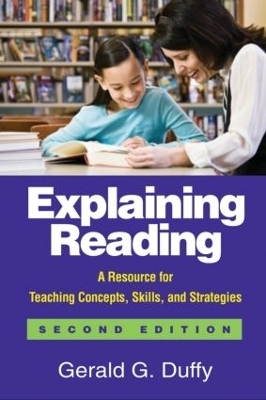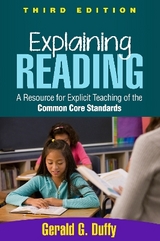
Explaining Reading
Guilford Publications (Verlag)
978-1-60623-076-3 (ISBN)
- Titel erscheint in neuer Auflage
- Artikel merken
New to This Edition
Incorporates important new research on vocabulary and comprehension
Stronger emphasis on embedding instruction in authentic reading experiences
A chapter on teaching "big-picture" ideas about the importance of reading
Revised teaching examples are even more thorough and teacher friendly.
Gerald G. Duffy, EdD, is the William Moran Distinguished Professor of Literacy and Reading at the University of North Carolina at Greensboro. Dr. Duffy spent 25 years teaching teachers how to teach reading and conducting research on classroom reading instruction at Michigan State University, where he was a Senior Researcher in the Institute for Research on Teaching and where he holds the rank of Professor Emeritus. He is also a former elementary and middle school teacher. A past President of the National Reading Conference and a member of the Reading Hall of Fame, Dr. Duffy has worked with teachers and children across the United States and overseas, has written and edited several books on reading instruction, and has published over 150 articles and research studies, with an emphasis on explicit teaching and teacher development.
Part I: Background to Explaining. The Foundation: Keeping the Main Thing the Main Thing. Skills and Strategies to Be Learned. Explaining the Forest as Well as the Trees. How to Use Part II of This Book. Decisions, Decisions, Decisions! Part II: Examples of How to Explain. Examples for Explaining Vocabulary. Example 1: Teaching Word Meanings Directly. Example 2: Using Semantic Maps to Develop Word Meaning. Example 3: Using Context to Figure Out Word Meanings. Example 4: Structural Analysis. Examples for Explaining Comprehension Strategies. xample 5: Predicting. Example 6: Monitoring, Questioning, and Repredicting. Example 7: Imaging. Example 8: Inferring. Example 9: Look-Backs as Fix-it Strategies. Example 10: Main Ideas. Example 11: Theme. Example 12: Summarizing. Example 13: Drawing Conclusions. Example 14: Evaluating. Example 15: Synthesizing. Examples for Explaining Word Recognition. Example 16: Attending to Print Detail. Example 17: Recognizing Words at Sight. Example 18: Phonemic Awareness. Example 19: Letter–sound Association. Example 20: Decoding by Analogy. Example 21: Context and Phonics in Combination. Examples for Explaining Fluency. Example 22: Quick Recognition of Look-Alike Words. Example 23: Intonation and Phrasing. Appendix: Additional Practical Teaching Resources.
| Erscheint lt. Verlag | 8.4.2009 |
|---|---|
| Verlagsort | New York |
| Sprache | englisch |
| Maße | 156 x 234 mm |
| Gewicht | 463 g |
| Themenwelt | Schulbuch / Wörterbuch |
| Sozialwissenschaften ► Pädagogik ► Schulpädagogik / Grundschule | |
| ISBN-10 | 1-60623-076-X / 160623076X |
| ISBN-13 | 978-1-60623-076-3 / 9781606230763 |
| Zustand | Neuware |
| Informationen gemäß Produktsicherheitsverordnung (GPSR) | |
| Haben Sie eine Frage zum Produkt? |
aus dem Bereich



